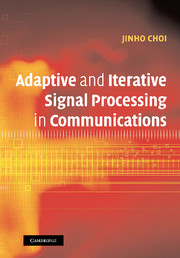Book contents
- Frontmatter
- Contents
- List of figures
- List of tables
- Preface
- List of symbols
- List of abbreviations
- 1 Introduction
- I ISI channels and adaptive signal processing
- II Iterative signal processing for ISI channels
- III Other interference-limited systems
- 8 CDMA systems and multiuser detection
- 9 Iterative CDMA receivers
- 10 Iterative receivers for multiple antenna systems
- 11 Coded OFDM and the iterative receiver
- Appendix 1 Review of signal processing and the Ƶ-transform
- Appendix 2 Important properties of matrices and vectors
- Appendix 3 Background for probability and statistics
- References
- Index
8 - CDMA systems and multiuser detection
Published online by Cambridge University Press: 23 November 2009
- Frontmatter
- Contents
- List of figures
- List of tables
- Preface
- List of symbols
- List of abbreviations
- 1 Introduction
- I ISI channels and adaptive signal processing
- II Iterative signal processing for ISI channels
- III Other interference-limited systems
- 8 CDMA systems and multiuser detection
- 9 Iterative CDMA receivers
- 10 Iterative receivers for multiple antenna systems
- 11 Coded OFDM and the iterative receiver
- Appendix 1 Review of signal processing and the Ƶ-transform
- Appendix 2 Important properties of matrices and vectors
- Appendix 3 Background for probability and statistics
- References
- Index
Summary
In a multiuser communication system, a multiple access scheme is required to share a common channel resource, e.g. the frequency band. For mobile multiuser communication systems, especially cellular systems, a code division multiple access (CDMA) scheme is widely employed due to several advantages over other schemes. In CDMA systems, users can transmit signals simultaneously over the same frequency band. This makes CDMA systems interference-limited since interfering signals (i.e. other users' signals) degrade the performance. To improve the performance of CDMA systems, multiuser detection has been investigated. Multiuser detection attempts to detect the desired signal as well as other signals (this implies a joint detection) for a better performance. Indeed, this is an analogy of the MLSD, in which a symbol sequence (i.e. multiple symbols), rather than individual symbols, is detected. There are also a number of different approaches taken to mitigate or suppress interfering signals for multiuser detection. In this chapter, we introduce CDMA systems and multiuser detectors; adaptive multiuser detectors are also introduced.
Overview of cellular systems
Cellular systems are wireless communication systems that can provide services over a large area. As the range of radio signals is limited, a cellular structure is employed to cover a large area. A cellular structure is shown in Fig. 8.1, in which each hexagonal area is called a cell. There is a basestation at the center of each cell. The role of the basestation is to communicate with mobile subscribers (i.e. users) within a cell. Hence, the size of the cell is closely related to the range of the radio signals between the basestation and users.
- Type
- Chapter
- Information
- Adaptive and Iterative Signal Processing in Communications , pp. 195 - 218Publisher: Cambridge University PressPrint publication year: 2006



